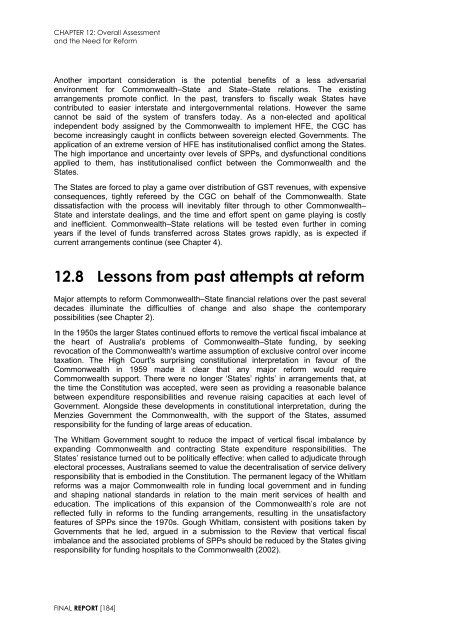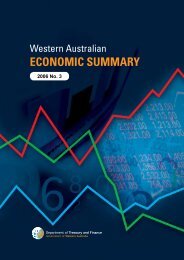Garnaut Fitzgerald Review of Commonwealth-State Funding
Garnaut Fitzgerald Review of Commonwealth-State Funding
Garnaut Fitzgerald Review of Commonwealth-State Funding
You also want an ePaper? Increase the reach of your titles
YUMPU automatically turns print PDFs into web optimized ePapers that Google loves.
CHAPTER 12: Overall Assessment<br />
and the Need for Reform<br />
Another important consideration is the potential benefits <strong>of</strong> a less adversarial<br />
environment for <strong>Commonwealth</strong>–<strong>State</strong> and <strong>State</strong>–<strong>State</strong> relations. The existing<br />
arrangements promote conflict. In the past, transfers to fiscally weak <strong>State</strong>s have<br />
contributed to easier interstate and intergovernmental relations. However the same<br />
cannot be said <strong>of</strong> the system <strong>of</strong> transfers today. As a non-elected and apolitical<br />
independent body assigned by the <strong>Commonwealth</strong> to implement HFE, the CGC has<br />
become increasingly caught in conflicts between sovereign elected Governments. The<br />
application <strong>of</strong> an extreme version <strong>of</strong> HFE has institutionalised conflict among the <strong>State</strong>s.<br />
The high importance and uncertainty over levels <strong>of</strong> SPPs, and dysfunctional conditions<br />
applied to them, has institutionalised conflict between the <strong>Commonwealth</strong> and the<br />
<strong>State</strong>s.<br />
The <strong>State</strong>s are forced to play a game over distribution <strong>of</strong> GST revenues, with expensive<br />
consequences, tightly refereed by the CGC on behalf <strong>of</strong> the <strong>Commonwealth</strong>. <strong>State</strong><br />
dissatisfaction with the process will inevitably filter through to other <strong>Commonwealth</strong>–<br />
<strong>State</strong> and interstate dealings, and the time and effort spent on game playing is costly<br />
and inefficient. <strong>Commonwealth</strong>–<strong>State</strong> relations will be tested even further in coming<br />
years if the level <strong>of</strong> funds transferred across <strong>State</strong>s grows rapidly, as is expected if<br />
current arrangements continue (see Chapter 4).<br />
12.8 Lessons from past attempts at reform<br />
Major attempts to reform <strong>Commonwealth</strong>–<strong>State</strong> financial relations over the past several<br />
decades illuminate the difficulties <strong>of</strong> change and also shape the contemporary<br />
possibilities (see Chapter 2).<br />
In the 1950s the larger <strong>State</strong>s continued efforts to remove the vertical fiscal imbalance at<br />
the heart <strong>of</strong> Australia's problems <strong>of</strong> <strong>Commonwealth</strong>–<strong>State</strong> funding, by seeking<br />
revocation <strong>of</strong> the <strong>Commonwealth</strong>'s wartime assumption <strong>of</strong> exclusive control over income<br />
taxation. The High Court's surprising constitutional interpretation in favour <strong>of</strong> the<br />
<strong>Commonwealth</strong> in 1959 made it clear that any major reform would require<br />
<strong>Commonwealth</strong> support. There were no longer ‘<strong>State</strong>s’ rights’ in arrangements that, at<br />
the time the Constitution was accepted, were seen as providing a reasonable balance<br />
between expenditure responsibilities and revenue raising capacities at each level <strong>of</strong><br />
Government. Alongside these developments in constitutional interpretation, during the<br />
Menzies Government the <strong>Commonwealth</strong>, with the support <strong>of</strong> the <strong>State</strong>s, assumed<br />
responsibility for the funding <strong>of</strong> large areas <strong>of</strong> education.<br />
The Whitlam Government sought to reduce the impact <strong>of</strong> vertical fiscal imbalance by<br />
expanding <strong>Commonwealth</strong> and contracting <strong>State</strong> expenditure responsibilities. The<br />
<strong>State</strong>s’ resistance turned out to be politically effective: when called to adjudicate through<br />
electoral processes, Australians seemed to value the decentralisation <strong>of</strong> service delivery<br />
responsibility that is embodied in the Constitution. The permanent legacy <strong>of</strong> the Whitlam<br />
reforms was a major <strong>Commonwealth</strong> role in funding local government and in funding<br />
and shaping national standards in relation to the main merit services <strong>of</strong> health and<br />
education. The implications <strong>of</strong> this expansion <strong>of</strong> the <strong>Commonwealth</strong>’s role are not<br />
reflected fully in reforms to the funding arrangements, resulting in the unsatisfactory<br />
features <strong>of</strong> SPPs since the 1970s. Gough Whitlam, consistent with positions taken by<br />
Governments that he led, argued in a submission to the <strong>Review</strong> that vertical fiscal<br />
imbalance and the associated problems <strong>of</strong> SPPs should be reduced by the <strong>State</strong>s giving<br />
responsibility for funding hospitals to the <strong>Commonwealth</strong> (2002).<br />
FINAL REPORT [184]

















